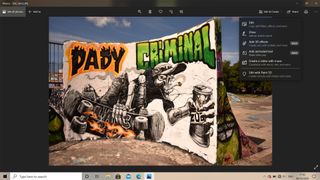The Windows 10 photo editor is simply called Photos, and you’ll find it in your Windows menu on your home computer or laptop. Unless you tell your operating system any different, it’ll be the default way that Windows opens your images when you select them from a folder. While it is very, very easy to use, you’ll find clear instructions on how to edit photos using the free app in Windows, right here (opens in new tab).
What can you do in the Windows 10 Photo app?
There are a handful of options for changing your photos in the Windows photo app, and they’re all very useful. You can change the color, clarity, and light levels in your images manually, or you can apply basic filters to each one. This is very much like the in-built photo editors on many of the best smartphones. You can also crop and rotate images, or zoom in to save a much closer crop than the one you took. This is handy for correcting any pictures that aren’t quite straight, and for removing unwanted objects like random people or ex-girlfriends from your picture. Once you’re all done with the basics, there are a handful of other features to use. If you want to draw or annotate your photo, you can do this using the limited range of brush and paint tools. It isn’t going to trouble the likes of Adobe Photoshop CC, but there are options here for pencilling a silly hat onto a friend, for example. Once finished, you can share your photo using any of the share functions available on your PC, or you can simply save it. If you’re signed up for OneDrive, which most of us are, your image will automatically be uploaded to the cloud (unless your storage is full).
What other photo software is available for Windows 10?
If this basic editor isn’t enough for you, there are loads of other options. Our guide to the best photo editing software will give you a run-down of the top-rated options. We personally recommend Adobe Lightroom CC if you’re interested in taking your images to the next level. It’s far easier to use than Photoshop, but incredibly powerful, and it’ll seriously change the way your photos look with just a few quick inputs. What’s more, you can share your images between PC and mobile, if you download the Lightroom app and sync your account up. So, if you add a picture to Lightroom on PC, it’ll automatically appear in the mobile app, along with any edits you’ve made. Photoshop CC is also a good option, especially if you want to get more creative and design-focused with your pictures. It’s overkill for more casual users, but Photoshop is the most powerful piece of graphic design software out there, and will allow you to do almost anything to an image if you know how to use it. This is more suited to professionals who want to actually create design projects, rather than anyone trying to make their selfie a little more Insta-friendly. We would also recommend something like CyberLink PhotoDirector 12, if you want to have more powerful enhancement and design tools in a single package. This is very easy to use, and allows you to add flashy effects to your images, like dispersion and movement. It’s a good way to transition into design from regular photo editing, and is ideal for beginners.
Are there any free photo editors for Windows 10?
Yes, there are a handful of free photo editing apps for Windows, but none as powerful, stable, or as ad-free as the premium software packages we listed above. In fact, if you’d rather not pay to edit your photos, the Windows Photos app is powerful enough for almost all situations. If you want to edit photos for reasons other than social media sharing, there are a handful of online apps that you can use through your browser instead. For things like personalized gift cards, business cards, or posters and invites, something like Adobe Spark is perfect and free. Canva offers good layout options too, although some features are locked behind a premium paywall. You can get offline apps for your Windows 10 PC, but almost all of them lock features or serve ads and in-app purchases at you.


